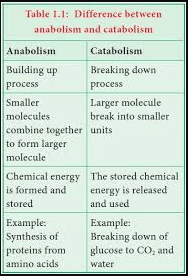Examples of Anabolism and Catabolism


While anabolism builds large molecules from smaller ones, catabolism is a reduction reaction where a complex molecule is converted into a simpler one.
Difference between Anabolism and Catabolism in Tabular form
| Anabolism | catabolism | |
|---|---|---|
| What is | The phase where the molecules that the body needs are built. | The process breaks down large molecules in the body into smaller ones. |
| phase-type | constructive. | destructive. |
| Energy | It is consumed by the body. | It releases it for the body. |
| Reaction | Endergonic, reduction and synthesis or construction. | Exergonic, decomposing or destructive and oxidative. |
| molecules | Complex molecules are produced from simple molecules. | Simple molecules are produced from complex molecules. |
| hormones |
|
|
| examples | When amino acids are converted to protein, glucose to glycogen, and fatty acids to triglycerides. | When proteins are converted to amino acids, proteins to glucose, glycogen to glucose, and triglycerides to fatty acids. |
What is anabolism?
The word anabolism comes from the Greek ana, which means ‘up’, and ballein , which we can translate as ‘throw’.
Anabolism is one of the two parts into which metabolism is divided, which is also known by the name biosynthesis.
Anabolism is a constructive chemical reaction where complex molecules are synthesized from simpler ones that can be organic or inorganic. Thus the molecules can grow and renew themselves, or be stored as energy reserves.
This metabolic process of construction, where energy is consumed to obtain large molecules from smaller ones, is possible thanks to the energy contribution of adenosine triphosphate (ATP).
In these reactions, the most oxidized compounds are reduced. Through anabolism, living things can form proteins from amino acids and thus maintain body tissues.
functions of anabolism
- Increase muscle mass.
- Form the cellular components and tissues of growth.
- Store energy.
stages of anabolism
- In the first stage, precursors are produced, such as amino acids, monosaccharides, and others.
- The precursors are then activated, using energy from adenosine triphosphate (ATP).
- In the third stage, more complex molecules are produced, such as proteins, polysaccharides, lipids, and nucleic acids.
You may also be interested in seeing Photosynthesis and respiration.
What is catabolism?
Catabolism is a word that comes from the Greek kato , which means ‘down’, and ballein , which means ‘to throw.
Catabolism is the part of the metabolic process by which different organic nutrients are degraded, reduced, or oxidized to their simplest forms so that the body assimilates them and transforms them into energy. This energy is essential for the functioning of anabolism.
The energy that is released is stored in adenosine triphosphate (ATP) molecules, and thus the cell can carry out vital actions such as muscle contraction and the synthesis of molecules.
It is a destructive phase of reduction where, from a complex organic molecule, such as carbohydrates and lipids, simpler ones such as H 2 O, CO 2 , lactic acid or ammonia are obtained.
A catabolic process is digestion , in which large molecular complexes are broken down and transformed into simpler forms so that they can be used as raw material and energy in anabolic processes. Because of this, digestion is essential for anabolism to work properly.
Bacteria are often capable of metabolizing iron and sulfur.
functions of catabolism
- degrade organic nutrients.
- Extract chemical energy from degraded nutrients to be used by the body.
- Nourish the body using tissues when there is a lack of food.
stages of catabolism
- Large organic molecules, such as proteins, polysaccharides, or lipids, are broken down to amino acids, monosaccharides, and fatty acids, respectively.
- The small molecules are brought into the cells and break down into even simpler molecules, releasing energy in the process.
- Finally, the coenzymes in the electron transport chain are oxidized.
You may also be interested in:
Related Post
Recent Posts
Difference between Gastritis and ulcer
Gastritis and ulcers are irritations, which must be treated urgently in order not to develop…
Saudi Arabia launches new residency plans to draw foreign talent
On Thursday, Saudi Arabia unveiled fresh residency programs geared towards drawing in skilled professionals and…
Study in UAE: Your Complete Guide to Enrolling Abroad
Studying abroad can be a life-changing experience, opening doors to new cultures, perspectives, and opportunities.…
Difference between Osmosis and dialysis
The difference between osmosis and dialysis is that Osmosis is a physical phenomenon by…
Difference between Vitamins and proteins
The Difference between Vitamins and Proteins is given here. Vitamins and proteins are essential…
Difference between Windows and Linux
The Difference between Windows and Linux is given here. Windows and Linux are operating systems…